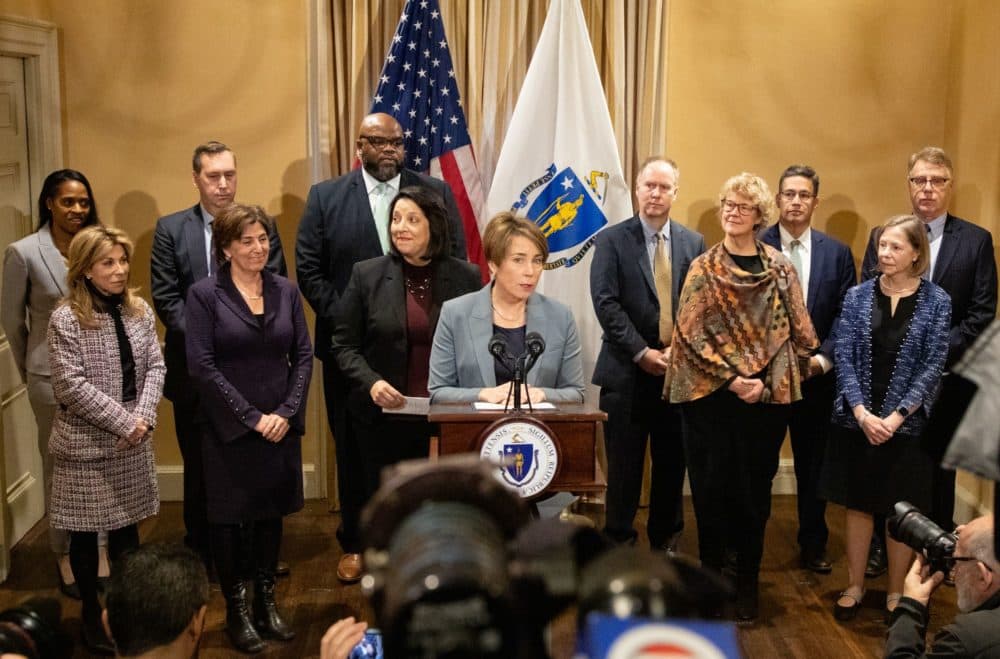Advertisement
Healey's first budget boosts spending on public education, green energy and the MBTA

Gov. Maura Healey's first state budget is a $55.5 billion package described as a "down payment" on the governor's goals of making Massachusetts a more affordable place to live, addressing climate change, and preparing students for an evolving economy.
The bottom line for fiscal year 2024 spending is a 4.1% increase over the current year's budget. The administration, as well as lawmakers, expect to see an increase in state revenues of about $1 billion from the state's new income surtax.
That $1 billion from the surtax on income in excess of $1 million will go toward Healey's spending on education ($510 million) and transportation ($490 million). Administration and Finance Secretary Matthew Gorzkowicz said that some of the investments the new governor's budget proposes "would be very challenging" to have made without the new revenue stream.
On the education side, Healey is proposing to use the surtax money to pay for $100 million in child care grants to providers, $140 million in higher education capital funding, and $20 million to establish a free community college program for people older than 25 without college degrees. She's also proposing a $93 million expansion of a state scholarship program, a $59 million effort to stabilize tuition and fees at UMass and other public higher education institutions, and more.
In total, higher education would be in line for an increase of $371 million or 23% in the Healey budget. That includes a 3% increase to the base funding for each higher education segment, including the University of Massachusetts system.
"Governor Healey and Lt. Governor Driscoll have made a bold statement about the importance of the University of Massachusetts to the socio-economic future of the Commonwealth," UMass President Marty Meehan said. "These transformational investments would expand access to our world-class education and enhance the impact of our statewide research enterprise."
For transportation, the surtax revenues would go towards $181 million in MBTA capital investments, launching a $100 million municipal partnership program, providing $100 million for highway bridge maintenance and preservation, and making $25 million available in regional transit funding and grants.
The budget plan also boosts funding for the Executive Office of Energy and Environmental Affairs, which sits at the center of the state's efforts to reduce carbon emissions to a net-zero level by 2050 and to electrify buildings, vehicles and more.
EEA would get $543.6 million under Healey's budget — an increase of 24% from the current year. That would allow the secretariat to hire 240 new staff members. The administration said it would be the first time an annual state budget dedicates at least 1% of its total to EEA.
After watching state revenues surge nearly 40% over the last two fiscal years, the administration and Legislature are preparing for a "slowcession" over the next year and a half — not a downturn from the elevated revenue levels, but a definite handbrake on the eye-popping increases of recent years.
Ahead of Wednesday's official filing of the complete budget, Healey previewed many of the central elements of her first spending plan.
She told local officials she would propose a total of $8.36 billion for local aid programs, which the administration said would be a $635 million or 8.2% increase over the final budget Gov. Charlie Baker signed for fiscal 2023. Along with $1.26 billion for general government aid (a $24.6 million or 2% increase), cities and towns would share $6.585 billion in Chapter 70 school funding (a $586 million or 9.8% boost) under Healey's plan.
The Healey administration said the Chapter 70 total it proposed represents full funding of the Student Opportunity Act school finance reform law passed in 2019. The law aims to address education equity gaps with $1.5 billion in new funds rolled out over a seven-year span.
Earlier this week, Healey also announced a tax relief and reform package that could swell to as much as $1 billion annually.